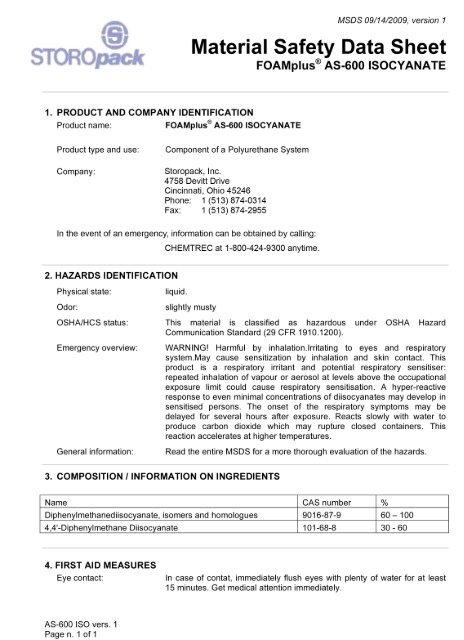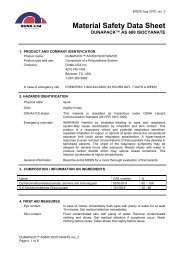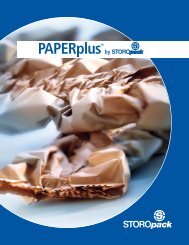Material Safety Data Sheet - Storopack
Material Safety Data Sheet - Storopack
Material Safety Data Sheet - Storopack
Create successful ePaper yourself
Turn your PDF publications into a flip-book with our unique Google optimized e-Paper software.
AS-600 ISO vers. 1<br />
Page n. 2 of 2<br />
MSDS 09/14/2009, version 1<br />
<strong>Material</strong> <strong>Safety</strong> <strong>Data</strong> <strong>Sheet</strong><br />
FOAMplus ® AS-600 ISOCYANATE<br />
Skin contact: Flush contaminated skin with plenty of water. Remove contaminated<br />
clothing and shoes. Get medical attention if symptoms occur. Wash<br />
clothing before reuse. Clean shoes thoroughly before reuse.<br />
Inhalation: If inhaled, remove to fresh air. If not breathing, give artificial respiration.<br />
Get medical attention immediately. Treatment is symptomatic for primary<br />
irritation or bronchospasm. If breathing is laboured, oxygen should be<br />
administered by qualified personnel.<br />
Ingestion: Wash out mouth with water. Move exposed person to fresh air. Do not<br />
induce vomiting unless directed to do so by medical personnel. Get<br />
medical attention if symptoms occur. Never give anything by mouth to an<br />
unconscious person.<br />
Notes to physician: Symptomatic and supportive therapy as needed. Following severe<br />
exposure medical follow-up should be monitored for at least 48 hours.<br />
5. FIRE-FIGHTING MEASURES<br />
Flash piont: Open cup: 230°C (446°F).<br />
Product of combustion: Combustion products may include: carbon oxides (CO, CO2) nitrogen<br />
oxides (NO, NO2 etc.) hydrocarbons and HCN.<br />
Extinguish media:<br />
Suitable: Use an extinguishing agent suitable for the surrounding fire.<br />
Not suitable: None known.<br />
Special exposure hazards: In a fire or if heated, a pressure increase will occur and the container may<br />
burst. No specific hazard.<br />
Special protective equipment for fire-fighters: Fire-fighters should wear appropriate protective<br />
equipment and self-contained breathing apparatus (SCBA) with a full facepiece<br />
operated in positive pressure mode. PVC boots gloves, safety<br />
helmet and protective clothing should be worn. PVC boots, gloves, safety<br />
helmet and protective clothing should be worn.<br />
Special remarks on explosion hazards: Due to reaction with water producing CO2-gas, a hazardous<br />
build-up of pressure could result if contaminated containers are re-sealed.<br />
Containers may burst if overheated.<br />
6. ACCIDENTAL RELEASE MEASURES<br />
Personal precautions: Immediately contact emergency personnel. Evacuate the area. Keep<br />
upwind to avoid inhalation of vapours. Clean-up should only be performed<br />
by trained personnel. People dealing with major spillages should wear full<br />
protective clothing including respiratory protection. Use suitable protective<br />
equipment (section 8).<br />
Environmental precautions: Avoid dispersal of spilled material and runoff and contact with soil,<br />
waterways, drains and sewers.<br />
Methods for cleaning up: Contain and absorb large spillages onto an inert, non-flammable<br />
adsorbent carrier (such as earth or sand). Shovel into open-top drums or<br />
plastic bags for further decontamination, if necessary. Wash the spillage
7. HANDLING AND STORAGE<br />
AS-600 ISO vers. 1<br />
Page n. 3 of 3<br />
MSDS 09/14/2009, version 1<br />
<strong>Material</strong> <strong>Safety</strong> <strong>Data</strong> <strong>Sheet</strong><br />
FOAMplus ® AS-600 ISOCYANATE<br />
area clean with liquid decontaminant. Test atmosphere for MDI. Neutralize<br />
small spillages with decontaminant. Remove and properly dispose of<br />
residues. (See Section 13 for disposal considerations.) Notify applicable<br />
government authorities if release is reportable. The CERCLA RQ for 4,4-<br />
MDI is 5,000 lbs (seeCERCLA in Section 15).<br />
Storage: Keep container in a cool, well-ventilated area. Keep container tightly<br />
closed. Keep away from moisture. Due to reaction with water producing<br />
CO2-gas, a hazardous build-up of pressure could result if contaminated<br />
containers are re-sealed. Do not reseal contaminated containers.<br />
Uncontaminated containers, free of moisture, may be resealed only after<br />
placing under a nitrogen blanket. Do not store in containers made of<br />
copper, copper alloys or galvanized surfaces.<br />
Handling: Put on appropriate personal protective equipment (see section 8). Eating,<br />
drinking and smoking should be prohibited in areas where this material is<br />
handled, stored and processed. Workers should wash hands and face<br />
before eating, drinking and smoking. Do not ingest. Avoid contact with<br />
eyes, skin and clothing. Avoid breathing vapor or mist. Keep in the original<br />
container or an approved alternative made from a compatible material,<br />
kept tightly closed when not in use. Empty containers retain product<br />
residue and can be hazardous. Do not reuse container.<br />
8. EXPOSURE CONTROLS / PERSONAL PROTECTION<br />
Exposure limits of Diphenylmethane 4,4'- diisocyanate: ACGIH TLV (United States, 1/2007).<br />
TWA: 0.05 ppm 8 hour(s). TWA: 0,01 ppm 8 hour(s).<br />
Consult local authorities for acceptable exposure limits<br />
NIOSH REL (United States, 12/2001).<br />
CEIL: 0.2 mg/m³ 10 minute(s). CEIL: 0.02 ppm 10 minute(s). TWA:<br />
0.05 mg/m³ 10 hour(s). TWA: 0.005 ppm 10 hour(s).<br />
OSHA PEL (United States, 11/2006).<br />
CEIL: 0,2 mg/m 3 0 hour(s) CEIL: 0.02 ppm 0 hour(s).<br />
OSHA PEL 1989 (United States, 3/1989).<br />
CEIL: 0.2 mg/m³. 0 hour(s) CEIL: 0.02 ppm 0 hour(s).<br />
Preventive Measures: Conditions of use, adequacy of engineering or other control measures,<br />
and actual exposures will dictate the need for specific protective devices at<br />
your workplace. Medical supervision of all employees who handle or come<br />
in contact with respiratory sensitizers is recommended. Persons with<br />
respiratory problems including asthmatic-type conditions, chronic<br />
bronchitis, other chronic respiratory diseases or recurrent skin eczema or<br />
skin allergies should be evaluated for their suitability of working with this<br />
product. Once a person is diagnosed as sensitized, no further exposure to<br />
the material that caused the sensitization should be permitted.
AS-600 ISO vers. 1<br />
Page n. 4 of 4<br />
MSDS 09/14/2009, version 1<br />
<strong>Material</strong> <strong>Safety</strong> <strong>Data</strong> <strong>Sheet</strong><br />
FOAMplus ® AS-600 ISOCYANATE<br />
Engineering controls: Use local exhaust ventilation to maintain airborne concentrations below<br />
the TLV. Suitable respiratory equipment should be used in cases of<br />
insufficient ventilation or where operational procedures demand it. For<br />
guidance on engineering control measures refer to publications such as<br />
the ACGIH current edition of 'Industrial Ventilation, a manual of<br />
Recommended Practice.'<br />
Personal protection:<br />
Eyes: Chemical safety goggles. If there is a potential for splashing, use a full<br />
face shield.<br />
Skin: The following protective materials are recommended: Gloves - neoprene,<br />
nitrile rubber, butyl rubber. Thin latex disposable gloves should be avoided<br />
for repeated or long term use. Protective clothing should be selected and<br />
used in accordance with 'Guidelines for the Selection of Chemical<br />
Protective Clothing' published by ACGIH.<br />
Respiratory : When the product is sprayed or heated without adequate ventilation, an<br />
approved MSHA/NIOSH positive-pressure, supplied-air respirator may be<br />
required. Air purifying respirators equipped with organic vapor cartridges<br />
and a HEPA (P100) particulate filter may be used under certain conditions<br />
when a cartridge change-out schedule has been developed in accordance<br />
with the OSHA respiratory protection standard (29 C.F.R. 1910.134).<br />
Hands : Chemical-resistant, impervious gloves complying with an approved<br />
standard should be worn at all times when handling chemical products if a<br />
risk assessment indicates this is necessary.<br />
Other protection : Consult your supervisor or S.O.P. for special handling instructions.<br />
9. PHYSICAL AND CHEMICAL PROPERTIES<br />
General information<br />
Appearance<br />
Physical state: Liquid<br />
Color: Brown.<br />
Odor: slightly musty.<br />
Odor threshold: Not available.<br />
Importanth health, safety and environmental information.<br />
Boiling point: >300°C decomposes<br />
Melting point: Not available.<br />
Flash point: Open cip: 230°C (446°F)<br />
Oxidizing properties: Not available.<br />
Saturated vapor concentration: >32 µg/m 3 at 20°C<br />
Vapor pressure: Not available.
Relative density: 1.23<br />
Vapor density: 8.5<br />
Auto-ignition temperature: >600°C<br />
VOC content: Not available<br />
10. STABILITY AND REACTIVITY<br />
AS-600 ISO vers. 1<br />
Page n. 5 of 5<br />
MSDS 09/14/2009, version 1<br />
<strong>Material</strong> <strong>Safety</strong> <strong>Data</strong> <strong>Sheet</strong><br />
FOAMplus ® AS-600 ISOCYANATE<br />
Stability and reactivity: Stable at room temperature. Reaction with water (moisture) produces<br />
C02-gas. Exothermic reaction with materials containing active hydrogen<br />
groups. The reaction becomes progressively more vigorous and can be<br />
violent at higher temperatures if the miscibility of the reaction partners is<br />
good or is supported by stirring or by the presence solvents. MDI is<br />
insoluble with, and heavier than water and sinks to the bottom but reac<br />
slowly at the interface. A solid water-insoluble layer of polyurea is formed<br />
at the interfac by liberating carbon dioxide gas.<br />
Conditions of instability: Avoid high temperatures.<br />
Incompatibility with various substances: water, alcohols, amines, bases, and acids.<br />
Hazardous polymerization: Polymerization may occur at elevated temperatures in the presence of<br />
alkalies, tertiary amines and metal compounds.<br />
Hazardous decomposition products: Combustion products may include: carbon oxides (CO, CO2)<br />
nitrogen oxides (NO, NO2 etc.) hydrocarbons and HCN.<br />
11. TOXICOLOGICAL INFORMATION<br />
Toxicity data<br />
Acute toxicity<br />
Product/ingredient name test Species Result Exposure<br />
Methylenediphenyldiisocyanate,<br />
isomers and homologues<br />
LD50 Dermal Rabbit >5000 mg/kg -<br />
LD50 Oral Rat >5000 mg/kg -<br />
LC50 Inhalation,<br />
dusts and mists<br />
Rat 0.49 mg/L 4 hours<br />
Diphenylmethane 4,4'- diisocyanate LD50 Dermal Rabbit >5000 mg/kg -<br />
Classification<br />
LD50 Oral Rat >5000 mg/kg -<br />
LC50 Inhalation,<br />
dusts and mists<br />
Methylenediphenyldiisocyanate, isomers and homologues IARC: 3<br />
Diphenylmethane 4,4'- diisocyanate IARC: 3<br />
Potential acute health effects<br />
Rat 0.49 mg/L 4 hours
AS-600 ISO vers. 1<br />
Page n. 6 of 6<br />
MSDS 09/14/2009, version 1<br />
<strong>Material</strong> <strong>Safety</strong> <strong>Data</strong> <strong>Sheet</strong><br />
FOAMplus ® AS-600 ISOCYANATE<br />
Ingestion: Low oral toxicity. Ingestion may cause irritation of the gastrointestinal tract.<br />
Inhalation: Toxic by inhalation. May cause sensitization by inhalation.<br />
Eyes: Irritating to eyes.<br />
Skin: Irritating to skin. May cause sensitisation by skin contact<br />
Potential acute health effects<br />
Target organs: Contains material which causes damage to the following organs: lungs,<br />
upper respiratory tract, skin.<br />
Carcinogenicity: Rats have been exposed for two years to a respirable aerosol of polymeric<br />
MDI which resulted in chronic pulmonary irritation at high concentrations.<br />
Only at the top level (6 mg/m 3 ), there was a significant incidence of a<br />
benign tumour of the lung (adenoma) and one malignant tumour<br />
(adenocarcinoma). There were no lung tumours at 1 mg/m 3 and no effects<br />
at 0.2 mg/m 3 . Overall, the tumour incidence, both benign and malignant,<br />
and the number of animals with the tumours were not different from<br />
controls. The increased incidence of lung tumours is associated with<br />
prolonged respiratory irritation and the concurrent accumulation of yellow<br />
material in the lung, which occurred throughout the study. In the absence<br />
of prolonged exposure to high concentrations leading to chronic irritation<br />
and lung damage, it is highly unlikely that tumour formation will occur.<br />
Mutagenicity: There is no substantial evidence of mutagenic potential.<br />
Teratogenicity: No birth defects were seen in two independant animal (rat) studies.<br />
Fetotoxicity was observed at doses that were extremely toxic (including<br />
lethal) to the mother. Fetotoxicity was not observed at doses that were not<br />
maternally toxic. The doses used in these studies were maximal,<br />
respirable concentrations, which are well in excess of defined occupational<br />
exposure limits.<br />
Developmental effects: No known significant effects or critical hazards.<br />
Fertility effects: No known significant effects or critical hazards.<br />
12. ECOLOGICAL INFORMATION<br />
Aquatic ecotoxicity<br />
Diphenylmethane 4,4'- diisocyanate : Acute EC50 >1000 mg/L for Daphnia (Expousure 48 hours) and<br />
for Fish (Exposure 96 hours).<br />
Mobility: By considering the production and use of the substance, it is unlikely that<br />
significant environmental exposure in the air or water will arise. Immiscible<br />
with water, but will react with water to produce inert and nonbiodegradable<br />
solids. Conversion to soluble products, including MDA, is<br />
very low under the optimal laboratory conditions of good dispersion and<br />
low concentration. In air, the predominant degradation process is<br />
predicted to be a relatively rapid OH radical attack, by calculation and by<br />
analogy with related diisocyanates.<br />
Environmental effects: By comparison with an analogous product, the following values are<br />
anticipated. The measured ecotoxicity is that of the hydrolised product,<br />
generally under conditions maximising production of soluble species. Even
13. DISPOSAL CONSIDERATIONS<br />
AS-600 ISO vers. 1<br />
Page n. 7 of 7<br />
MSDS 09/14/2009, version 1<br />
<strong>Material</strong> <strong>Safety</strong> <strong>Data</strong> <strong>Sheet</strong><br />
FOAMplus ® AS-600 ISOCYANATE<br />
so, the observed ecotoxicity is low/very low. A pond study showed gross<br />
contamination caused no significant toxic effects on a wide variety of flora<br />
in all trophic levels (including fish), no detectable MDA, and no evidence of<br />
bioaccumulation of MDI or MDA.<br />
Waste disposal: The generation of waste should be avoided or minimized wherever<br />
possible. Empty containers or liners may retain some product residues.<br />
This material and its container must be disposed of in a safe way. Dispose<br />
of surplus and non-recyclable products via a licensed waste disposal<br />
contractor. Disposal of this product, solutions and any by- products should<br />
at all times comply with the requirements of environmental protection and<br />
waste disposal legislation and any regional local authority requirements.<br />
Avoid dispersal of spilled material and runoff and contact with soil,<br />
waterways, drains and sewers.<br />
14. TRANSPORT INFORMATION<br />
DOT Classification: UN number: UN3082; Proper shipping name: ENVIRONMENTALLY<br />
HAZARDOUS SUBSTANCES, LIQUID, N.O.S. (Methylene Diphenyl<br />
Diisocyanate); Class: 9; Packing group: III; Additional information:<br />
Reportable quantity is 5000 lbs and single containers less than 5000 lbs<br />
are not regulated.<br />
TDG Classification, IMDG Class, IATA-DGR Class: Not regulated.<br />
15. REGULATORY INFORMATION<br />
United States<br />
HCS Classification: Toxic material, Irritant, Sensitizer<br />
U.S. Federal regulations: United States inventory (TSCA 8b): All components are listed or<br />
exempted. TSCA 12(b) one-time export: Chlorobenzene<br />
16. OTHER INFORMATION<br />
Label requirements: Harmful by inhalation. Irritating to eyes and respiratory system.May cause<br />
sensitization by inhalation and skin contact. This product is a respiratory<br />
irritant and potential respiratory sensitiser: repeated inhalation of vapour or<br />
aerosol at levels above the occupational exposure limit could cause<br />
respiratory sensitisation. A hyper-reactive response to even minimal<br />
concentrations of diisocyanates may develop in sensitised persons. The<br />
onset of the respiratory symptoms may be delayed for several hours after<br />
exposure.<br />
Hazardous <strong>Material</strong> Information System (U.S.A.): National Fire Protection Association (U.S.A.):
Date of printing: 06/15/2009<br />
Date of issue: 06/15/2009<br />
Notice to reader<br />
AS-600 ISO vers. 1<br />
Page n. 8 of 8<br />
MSDS 09/14/2009, version 1<br />
<strong>Material</strong> <strong>Safety</strong> <strong>Data</strong> <strong>Sheet</strong><br />
FOAMplus ® AS-600 ISOCYANATE<br />
While the information and recommendations in this publication are to the best of our knowledge,<br />
information and belief accurate at the date of publication, NOTHING HEREIN IS TO BE CONSTRUED<br />
AS A WARRANTY, EXPRESS OR OTHERWISE.<br />
IN ALL CASES, IT IS THE RESPONSIBILITY OF THE USER TO DETERMINE THE APPLICABILITY<br />
OF SUCH INFORMATION AND RECOMMENDATIONS AND THE SUITABILITY OF ANY PRODUCT<br />
FOR ITS OWN PARTICULAR PURPOSE.<br />
THE PRODUCT MAY PRESENT HAZARDS AND SHOULD BE USED WITH CAUTION. WHILE<br />
CERTAIN HAZARDS ARE DESCRIBED IN THIS PUBLICATION, NO GUARANTEE IS MADE THAT<br />
THESE ARE THE ONLY HAZARDS THAT EXIST.<br />
Hazards, toxicity and behaviour of the products may differ when used with other materials and are<br />
dependent upon the manufacturing circumstances or other processes. Such hazards, toxicity and<br />
behaviour should be determined by the user and made known to handlers, processors and end users.
















